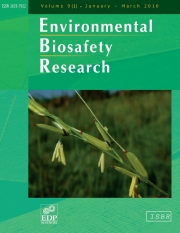Crossref Citations
This article has been cited by the following publications. This list is generated based on data provided by
Crossref.
Kavanagh, Vanessa B.
Hall, Linda M.
and
Hall, Jocelyn C.
2010.
Potential Hybridization of Genetically Engineered Triticale with Wild and Weedy Relatives in Canada.
Crop Science,
Vol. 50,
Issue. 4,
p.
1128.
Jhala, A J
Bhatt, H
Topinka, K
and
Hall, L M
2011.
Pollen-mediated gene flow in flax (Linum usitatissimum L.): can genetically engineered and organic flax coexist?.
Heredity,
Vol. 106,
Issue. 4,
p.
557.
Badea, A.
Eudes, F.
Salmon, D.
Tuvesson, S.
Vrolijk, A.
Larsson, C.-T.
Caig, V.
Huttner, E.
Kilian, A.
and
Laroche, André
2011.
Development and assessment of DArT markers in triticale.
Theoretical and Applied Genetics,
Vol. 122,
Issue. 8,
p.
1547.
Zhang, Li
Wang, Jin
Zhou, Ronghua
and
Jia, Jizeng
2011.
Discovery of quantitative trait loci for crossability from a synthetic wheat genotype.
Journal of Genetics and Genomics,
Vol. 38,
Issue. 8,
p.
373.
Han, Ouk-Kyu
Park, Tae-Il
Park, Hyung-Ho
Song, Tae-Hwa
Ju, Jung-Il
Jeung, Jae-Hyun
Kang, Sung-Joo
Kim, Dae-Ho
Choi, Hong-Jib
Park, Nam-Geon
Kim, Kee-Jong
Hwang, Jong-Jin
Baek, Seong-Beum
and
Kwon, Young-Up
2012.
'Joseong', a New Early-Heading Forage Triticale Cultivar for Paddy Field of Double Cropping.
Journal of The Korean Society of Grassland and Forage Science,
Vol. 32,
Issue. 3,
p.
193.
Olivera, P. D.
Pretorius, Z. A.
Badebo, A.
and
Jin, Y.
2013.
Identification of Resistance to Races of Puccinia graminis f. sp. tritici with Broad Virulence in Triticale (×Triticosecale).
Plant Disease,
Vol. 97,
Issue. 4,
p.
479.
Kavanagh, Vanessa B.
Hills, Melissa J.
Goyal, Aakash
Randhawa, Harpinder S.
Topinka, A. Keith
Eudes, Francois
and
Hall, Linda M.
2013.
Molecular markers as a complementary tool in risk assessments: quantifying interspecific gene flow from triticale to spring wheat and durum wheat.
Transgenic Research,
Vol. 22,
Issue. 4,
p.
767.
Warzecha, Tomasz
Sutkowska, Agnieszka
and
Góral, Halina
2014.
Male sterility of triticale lines generated through recombination of triticale and rye maintainers.
Spanish Journal of Agricultural Research,
Vol. 12,
Issue. 4,
p.
1124.
Badiyal, A.
Chaudhary, H.K.
Jamwal, N.S.
Hussain, W.
Mahato, A.
and
Bhatt, A.K.
2014.
Interactive genotypic influence of triticale and wheat on their crossability and haploid induction under varied agroclimatic regimes.
Cereal Research Communications,
Vol. 42,
Issue. 4,
p.
700.
Machczyńska, Joanna
Zimny, Janusz
and
Bednarek, Piotr Tomasz
2015.
Tissue culture-induced genetic and epigenetic variation in triticale (× Triticosecale spp. Wittmack ex A. Camus 1927) regenerants.
Plant Molecular Biology,
Vol. 89,
Issue. 3,
p.
279.
Kavanagh, Vanessa
and
Hall, Linda
2015.
Triticale.
p.
3.
Mallory-Smith, Carol
Hall, Linda M.
and
Burgos, Nilda R.
2015.
Experimental Methods to Study Gene Flow.
Weed Science,
Vol. 63,
Issue. SP1,
p.
12.
Randhawa, H. S.
Bona, L.
and
Graf, R. J.
2015.
Triticale.
p.
15.
Jamwal, Navdeep S.
Chaudhary, H. K.
Badiyal, Anila
and
Hussain, Waseem
2016.
Factors influencing crossability among triticale and wheat and its subsequent effect along with hybrid necrosis on haploid induction.
Acta Agriculturae Scandinavica, Section B — Soil & Plant Science,
Vol. 66,
Issue. 3,
p.
282.
Han, Ouk-Kyu
Park, Hyung-Ho
Park, Tae-Il
Oh, Young-Jin
Song, Tae-Hwa
Kim, Dea-Wook
Chae, Hyun-Seok
Hong, Ki-Heung
Bae, Jeong-Suk
Kim, Ki-Soo
Yun, Geon-Sig
Lee, Seong-Tae
Ku, Ja-Hwan
Kweon, Soon-Jong
Ahn, Jong-Woong
and
Kim, Byung-Joo
2016.
A New Early-Heading, High-Yielding Triticale Cultivar for Forage, ‘Shinseong’.
Journal of The Korean Society of Grassland and Forage Science,
Vol. 36,
Issue. 2,
p.
142.
Lachman, Jaromír
Martinek, Petr
Kotíková, Zora
Orsák, Matyáš
and
Šulc, Miloslav
2017.
Genetics and chemistry of pigments in wheat grain – A review.
Journal of Cereal Science,
Vol. 74,
Issue. ,
p.
145.
Sutkowska, Agnieszka
Boroń, Piotr
Warzecha, Tomasz
Dębowski, Jakub
and
Mitka, Józef
2017.
Hybridization and introgression among three Aconitum (Ranunculaceae) species of different ploidy levels in the Tatra Mountains (Western Carpathians).
Plant Species Biology,
Vol. 32,
Issue. 4,
p.
292.
Mupondwa, Edmund
Li, Xue
and
Tabil, Lope
2018.
Integrated bioethanol production from triticale grain and lignocellulosic straw in Western Canada.
Industrial Crops and Products,
Vol. 117,
Issue. ,
p.
75.
Li, Feng
Li, Yinghui
Cao, Lirong
Liu, Peiyuan
Geng, Miaomiao
Zhang, Qiang
Qiu, Lina
Sun, Qixin
and
Xie, Chaojie
2018.
Simultaneous Transfer of Leaf Rust and Powdery Mildew Resistance Genes from Hexaploid Triticale Cultivar Sorento into Bread Wheat.
Frontiers in Plant Science,
Vol. 9,
Issue. ,
Park, Seung Min
Shin, Dong-Hyun
and
Kim, Ki-Yong
2019.
Growth Characteristics and Productivity of Korean Winter Forage Crops in Uzbekistan.
Journal of The Korean Society of Grassland and Forage Science,
Vol. 39,
Issue. 3,
p.
158.

